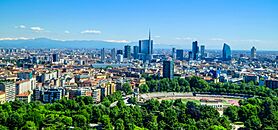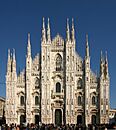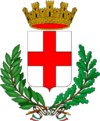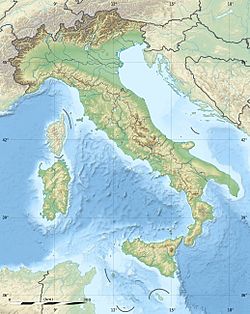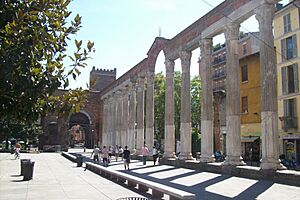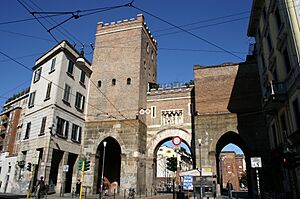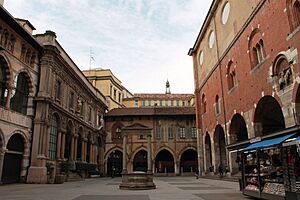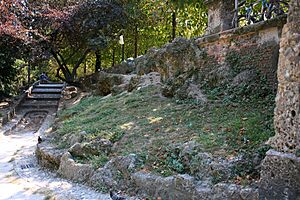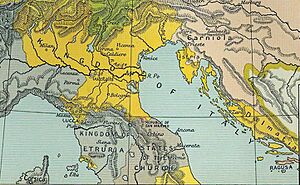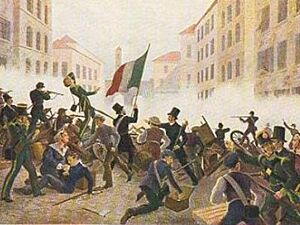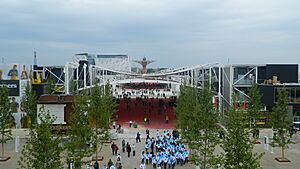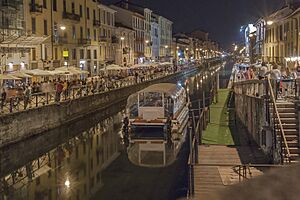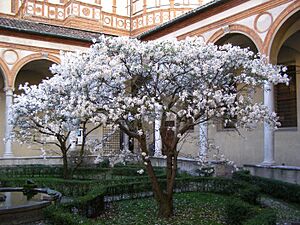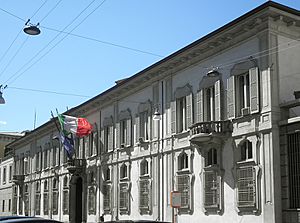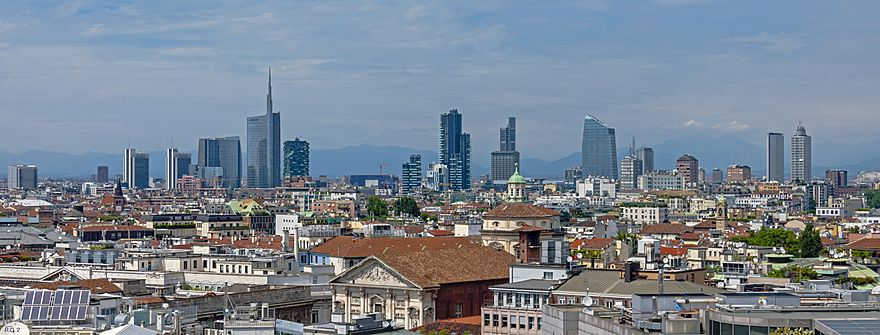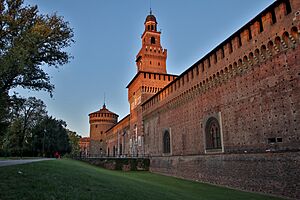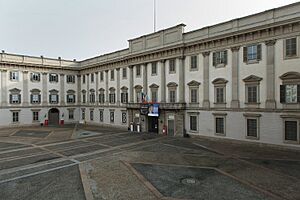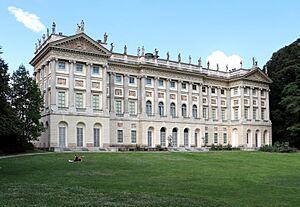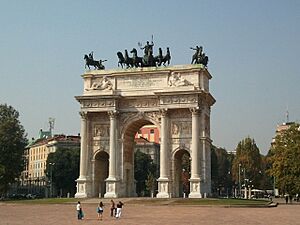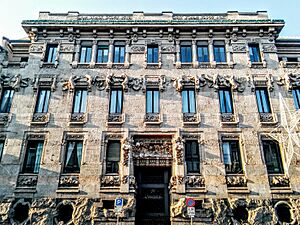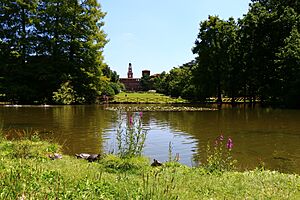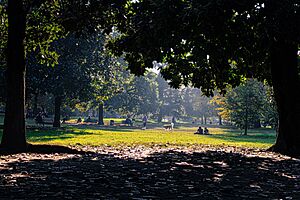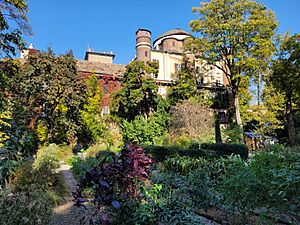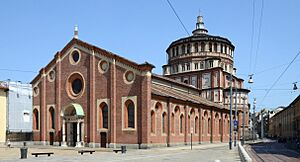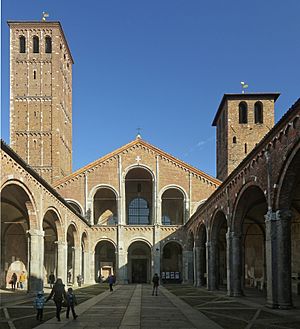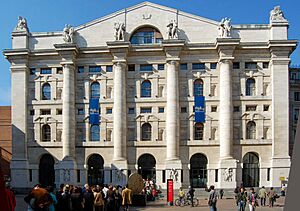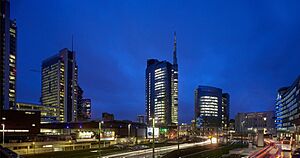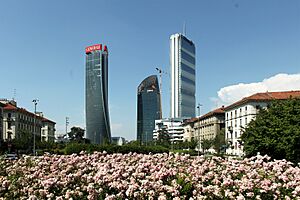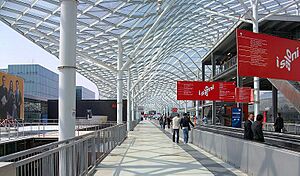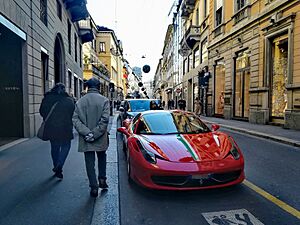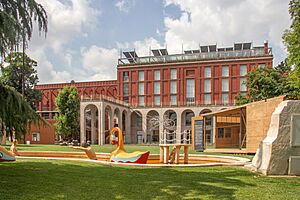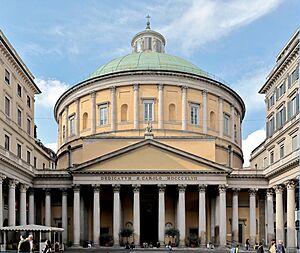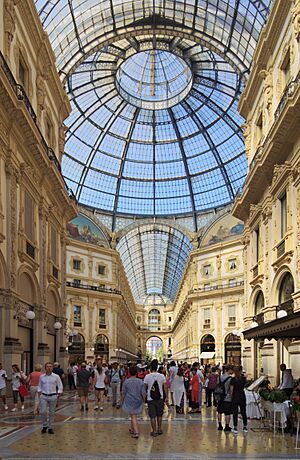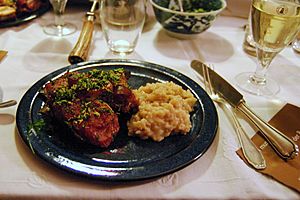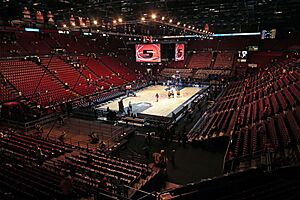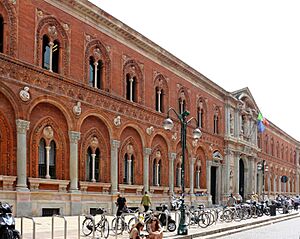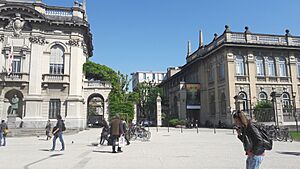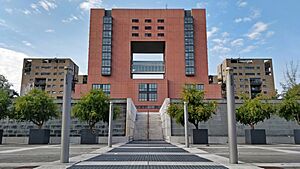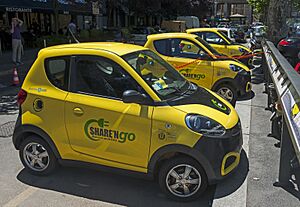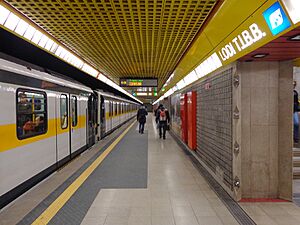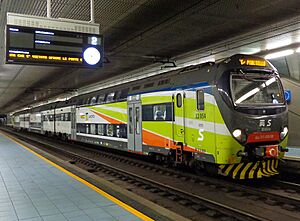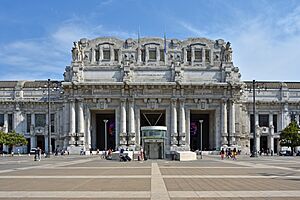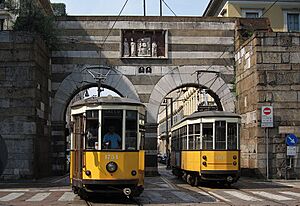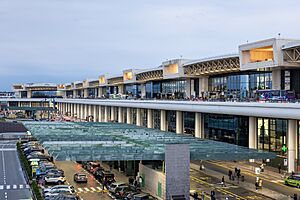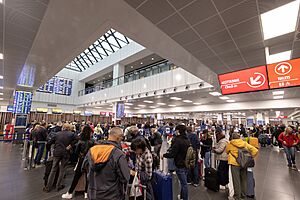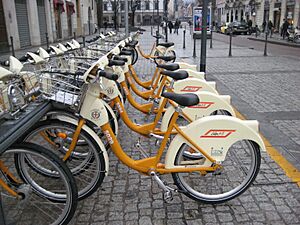Milan facts for kids
Quick facts for kids
Milan
Milano (Italian)
|
|||
|---|---|---|---|
| Comune di Milano | |||
|
Skyline of Milan with Porta Nuova business district
Arch of Peace
Sforza Castle
Galleria Vittorio Emanuele II
Milano Centrale
San Carlo al Corso
|
|||
|
|||
| Country | Italy | ||
| Region | |||
| Metropolitan city | |||
| Government | |||
| • Type | Strong Mayor–Council | ||
| Area | |||
| • Comune | 181.76 km2 (70.18 sq mi) | ||
| Elevation | 120 m (390 ft) | ||
| Population
(1 January 2022)
|
|||
| • Comune | 1,371,498 | ||
| • Density | 7,545.65/km2 (19,543.2/sq mi) | ||
| • Metro | 4,336,121 | ||
| Demonym(s) | Milanese Meneghino |
||
| GDP | |||
| • Metro | €204,514 billion (2020) | ||
| Time zone | UTC+1 (CET) | ||
| • Summer (DST) | UTC+2 (CEST) | ||
| Area code(s) | 0039 02 | ||
| Website | www.comune.milano.it | ||
| Click on the map for a fullscreen view | |||
Milan is a big city in northern Italy. It is the capital of the Lombardy region. Milan is the second-largest city in Italy by population, after Rome. About 1.4 million people live in the city itself. If you count the wider metropolitan area, it's home to over 8 million people, making it the largest in Italy.
Milan is super important for Italy's economy. It's a global center for art, design, fashion, money, and tourism. Italy's stock exchange is here, along with many big banks and companies. Milan is the richest city in Italy. It's also one of the most visited cities in the world, famous for its museums and art, including works by Leonardo da Vinci.
The city was founded around 590 BC by a Celtic tribe. The Romans took it over in 222 BC. Later, it became the capital of the Western Roman Empire. From the 12th to the 16th century, Milan was a huge European city and a major trade center. It was the capital of the Duchy of Milan, a powerful place for art and fashion during the Renaissance. In the 20th century, Milan became Italy's main industrial and financial hub.
Milan is known as one of the world's four fashion capitals. Many famous luxury fashion brands like Armani and Prada have their main offices here. The city also hosts big events like Milan Fashion Week and the Milan Furniture Fair. In sports, Milan has two very successful football teams: AC Milan and Inter Milan. Milan will also host the 2026 Winter Olympics and 2026 Winter Paralympics in 2026, along with Cortina d'Ampezzo.
Contents
What's in a Name?
Milan was first called Medhelanon by the Celts. The ancient Romans later changed it to Mediolanum. In the Celtic language, medhe- meant "middle" or "center." The part -lanon was like the Latin word -planum, meaning "plain." So, Mediolanum could mean "settlement in the middle of the plain." It might also mean "place between watercourses," because of the rivers nearby.
Some people think lanum comes from a Celtic word meaning an enclosed or marked territory, like a special place for a shrine. So, Mediolanum could mean the central town or holy place of a Celtic tribe. There were about sixty other Roman sites in France with "Mediolanum" in their names.
Another idea links the name to the scrofa semilanuta or "half-woolly sow." This was an old symbol of the city. A story says that when the city walls were first built, a boar was found during digging. This boar was said to be "half-wool," which some linked to the name Mediolanum.
Milan's Long History
Early Celtic Times
Around 590 BC, a Celtic tribe called the Insubres settled the area and named it Medhelanon. A Roman historian named Livy wrote that a Gaulish king sent his nephew, Bellovesus, to northern Italy. Bellovesus supposedly founded the settlement during the time of the Roman monarchy.
Medhelanon grew around a special holy place, or sanctuary. This sanctuary was an oval-shaped wooded area with a clearing in the middle. It was set up based on the stars and used for religious meetings. The city's early roads followed the shape of this ancient sanctuary.
About 200 years after the sanctuary was built, people started building homes around it. Medhelanon then changed from just a religious center to a real town, and later, a military hub.
Roman Rule
During the Roman Republic, Roman soldiers took control of the settlement in 222 BC. They renamed it Mediolanum. This city became the most important center in the region called "Cisalpine Gaul" (meaning "Gaul on this side of the Alps"). In 49 BC, it became a municipium, which was an important Roman town.

The Roman city was built right on top of the old Celtic settlement. Over time, the medieval city was built over the Roman one. Milan has kept growing around its first Celtic core. In 286 AD, the Roman Emperor Diocletian moved the capital of the Western Roman Empire from Rome to Mediolanum.
Mediolanum was known for its schools. It had a theater and a huge amphitheater, one of the largest in Roman Italy. Emperor Maximian built many grand buildings, including a large circus and imperial palaces. He also built a new, bigger stone wall around the city.
In 313 AD, Emperor Constantine issued the Edict of Milan from here. This important law allowed all religions to be practiced freely in the Empire, which helped Christianity grow. In 402 AD, the Visigoths attacked the city, and the Emperor moved his home to Ravenna. Later, in 452 AD, Attila attacked Milan. The city suffered greatly during the Gothic War in 539 AD.
Medieval Times
After the Visigoths attacked in 402 AD, the imperial residence moved away. Attila, the King of the Huns, also attacked and damaged the city in 452 AD. In 539 AD, the Ostrogoths conquered and destroyed Milan. In 569 AD, the Lombards took over Milan. The name of the region, Lombardy, comes from them. Milan later surrendered to Charlemagne and the Franks in 774 AD.
In the 11th century, cities in northern Italy started to become independent from the Holy Roman Emperors. Milan became a city-state. The Milanese often fought with nearby cities. This led to a lot of Milan being destroyed in 1162.
After this, Milan had a time of peace and grew rich as a trade center. It was considered one of the biggest European cities. In 1395, Gian Galeazzo Visconti became the first Duke of Milan. In 1447, the Golden Ambrosian Republic was formed, named after St. Ambrose. But this republic didn't last long. In 1450, Francesco I Sforza took over, and Milan became a leading city of the Italian Renaissance. Under the Sforza family, Milan became very wealthy, especially from growing mulberry trees and processing silk.
During this time, important buildings like the Sforza Castle and the Ospedale Maggiore were finished. The Sforzas also brought famous artists like Leonardo da Vinci and Bramante to Milan. Leonardo improved the city's canals and painted The Last Supper.
Early Modern Times
Milan's last independent ruler, Lodovico il Moro, asked for help from Charles VIII of France. This led to the Italian Wars. In 1500, Louis XII of France claimed Milan. After a big battle, the Duchy of Milan was promised to the French king. But when the Spanish Emperor Charles V defeated the French in 1525, Milan became part of Habsburg Spain.
In 1629–31, a terrible plague hit Milan, causing huge devastation. This event was seen as a sign of bad Spanish rule. In 1706, the French lost control of northern Italy to the Austrian Habsburgs. So, Milan became part of the Austrian Empire.
Napoleon invaded Italy in 1796. He made Milan the capital of the Cisalpine Republic and later the Kingdom of Italy. He was even crowned King of Italy in the cathedral. After Napoleon's rule ended, Milan returned to Austrian control in 1815.
Recent History
On March 18, 1848, Milan rebelled against Austrian rule in what was called the "Five Days." This forced the Austrian army to leave the city for a short time. The nearby Kingdom of Piedmont–Sardinia sent troops to help. But a few months later, the Austrians came back and took control again.
About ten years later, Italian leaders like Cavour and Garibaldi worked to unite Italy. They allied with France to defeat Austria. After a big battle in 1859, Milan and Lombardy became part of Piedmont-Sardinia. This led to the creation of the Kingdom of Italy on March 17, 1861.
After Italy was united, Milan became even more important for the economy of northern Italy. A large railway network made Milan a major transport hub. The city also developed strong steel and textile industries. Milan's banks became very powerful, making it the country's leading financial center.

In the Second World War, Milan's factories and transport systems were heavily bombed by the Allies. Many homes were also hit. When Italy surrendered in 1943, German forces took over northern Italy. But the Italian resistance movement fought back. On April 29, 1945, the resistance took control of Milan and captured Benito Mussolini.
After the war, Milan rebuilt quickly. This period was called the "Italian economic miracle." Many people moved to Milan from other parts of Italy. The city's population grew a lot. New, modern skyscrapers like the Torre Velasca and the Pirelli Tower were built. However, the late 1960s and early 1970s saw a lot of street violence and political problems.
In the 1980s, Milan became one of the world's fashion capitals, thanks to brands like Armani and Versace. More tourists started visiting. In the 1990s, Milan faced some financial problems and a decline in traditional industries. But new housing projects helped bring new energy to the city.
In the early 21st century, Milan started to redevelop old industrial areas. Two new business districts, Porta Nuova and CityLife, were built, changing the city's skyline. Milan has become a global center for innovation. It successfully hosted big international events like Expo 2015 and will host the 2026 Winter Olympics.
Milan's Location and Climate
Where is Milan?
Milan is in the northwestern part of the Po Valley, a large flat area. It's about halfway between the Po River to the south and the Alps mountains and big lakes to the north. The city's land is flat.
The city area itself is about 181 square kilometers. The larger Metropolitan City of Milan covers about 1,575 square kilometers. The city center has a circular shape because of the Navigli, an old system of canals that are now mostly covered. Today, the Navigli area is very lively with many homes, bars, and restaurants. It's also a popular spot for artists.
Milan's Weather
Milan has a humid subtropical climate. This means it has four seasons, with hot, humid summers and cold, often foggy winters. The Alps and Apennine Mountains protect the city from cold winds from northern Europe.
In winter, daily temperatures can drop below freezing. Snow can fall, with an average of 25 cm between 1961 and 1990. The city used to be very foggy in winter, but this happens less now. Sometimes, warm winds can cause temperatures to rise unexpectedly in winter. Air pollution can be high in winter.
Summers in Milan are hot and humid, with temperatures sometimes going above 35°C. Nights can stay muggy because of the humidity and lack of wind. Summers usually have clear skies. When it does rain, it's often with thunderstorms and hail. Spring and autumn are generally pleasant, with temperatures between 10°C and 20°C. These seasons have more rain. Milan is one of the least windy cities in Europe because it's surrounded by mountains.
| Climate data for Linate Airport, Milan (1991–2020 normals, sun 1981-2010, extremes 1946–present) | |||||||||||||
|---|---|---|---|---|---|---|---|---|---|---|---|---|---|
| Month | Jan | Feb | Mar | Apr | May | Jun | Jul | Aug | Sep | Oct | Nov | Dec | Year |
| Record high °C (°F) | 21.7 (71.1) |
23.8 (74.8) |
26.9 (80.4) |
32.4 (90.3) |
35.5 (95.9) |
36.6 (97.9) |
37.2 (99.0) |
39.3 (102.7) |
33.2 (91.8) |
28.2 (82.8) |
25.5 (77.9) |
24.5 (76.1) |
39.3 (102.7) |
| Mean daily maximum °C (°F) | 7.3 (45.1) |
10.0 (50.0) |
15.5 (59.9) |
19.3 (66.7) |
23.9 (75.0) |
28.1 (82.6) |
30.7 (87.3) |
29.9 (85.8) |
25.5 (77.9) |
19.0 (66.2) |
12.4 (54.3) |
7.4 (45.3) |
19.1 (66.3) |
| Daily mean °C (°F) | 3.2 (37.8) |
5.2 (41.4) |
9.9 (49.8) |
13.8 (56.8) |
18.5 (65.3) |
22.7 (72.9) |
25.1 (77.2) |
24.4 (75.9) |
19.9 (67.8) |
14.4 (57.9) |
8.7 (47.7) |
3.9 (39.0) |
14.1 (57.5) |
| Mean daily minimum °C (°F) | −0.4 (31.3) |
0.6 (33.1) |
4.4 (39.9) |
8.4 (47.1) |
12.8 (55.0) |
17.2 (63.0) |
19.3 (66.7) |
18.8 (65.8) |
14.9 (58.8) |
10.2 (50.4) |
5.3 (41.5) |
0.6 (33.1) |
9.3 (48.8) |
| Record low °C (°F) | −15.0 (5.0) |
−15.6 (3.9) |
−7.4 (18.7) |
−2.5 (27.5) |
−0.8 (30.6) |
5.6 (42.1) |
8.4 (47.1) |
8.0 (46.4) |
3.0 (37.4) |
−2.3 (27.9) |
−6.2 (20.8) |
−13.6 (7.5) |
−15.6 (3.9) |
| Average precipitation mm (inches) | 35.9 (1.41) |
38.2 (1.50) |
42.2 (1.66) |
57.7 (2.27) |
70.3 (2.77) |
67.4 (2.65) |
44.2 (1.74) |
82.2 (3.24) |
73.4 (2.89) |
82.0 (3.23) |
112.4 (4.43) |
45.8 (1.80) |
751.7 (29.59) |
| Average precipitation days (≥ 1.0 mm) | 4.7 | 4.5 | 5.4 | 7.2 | 8.4 | 6.6 | 4.5 | 5.5 | 5.1 | 6.6 | 8.3 | 5.7 | 72.5 |
| Average relative humidity (%) | 78.9 | 73.6 | 68.0 | 67.7 | 67.2 | 66.9 | 66.2 | 67.4 | 70.0 | 76.5 | 81.0 | 81.8 | 72.1 |
| Average dew point °C (°F) | 0.2 (32.4) |
0.8 (33.4) |
3.9 (39.0) |
7.0 (44.6) |
11.2 (52.2) |
14.7 (58.5) |
16.6 (61.9) |
16.8 (62.2) |
13.4 (56.1) |
10.1 (50.2) |
5.9 (42.6) |
1.2 (34.2) |
8.5 (47.3) |
| Mean monthly sunshine hours | 91.4 | 108.5 | 170.0 | 178.4 | 212.3 | 247.6 | 293.2 | 237.6 | 179.3 | 116.5 | 73.3 | 67.1 | 1,975.2 |
| Source 1: NOAA NCEI | |||||||||||||
| Source 2: Istituto Superiore per la Protezione e la Ricerca Ambientale | |||||||||||||
| Climate data for Malpensa Airport, Milan (1961–1990 normals, extremes 1951–present) | |||||||||||||
|---|---|---|---|---|---|---|---|---|---|---|---|---|---|
| Month | Jan | Feb | Mar | Apr | May | Jun | Jul | Aug | Sep | Oct | Nov | Dec | Year |
| Record high °C (°F) | 22.4 (72.3) |
24.4 (75.9) |
28.9 (84.0) |
31.6 (88.9) |
35.1 (95.2) |
37.6 (99.7) |
38.2 (100.8) |
38.8 (101.8) |
33.9 (93.0) |
29.8 (85.6) |
22.8 (73.0) |
20.8 (69.4) |
38.8 (101.8) |
| Mean daily maximum °C (°F) | 6.1 (43.0) |
8.6 (47.5) |
13.1 (55.6) |
17.0 (62.6) |
21.3 (70.3) |
25.5 (77.9) |
28.6 (83.5) |
27.6 (81.7) |
24.0 (75.2) |
18.2 (64.8) |
11.2 (52.2) |
6.9 (44.4) |
17.3 (63.2) |
| Daily mean °C (°F) | 0.9 (33.6) |
3.1 (37.6) |
6.8 (44.2) |
10.7 (51.3) |
15.2 (59.4) |
19.1 (66.4) |
22.0 (71.6) |
21.2 (70.2) |
17.8 (64.0) |
12.3 (54.1) |
6.0 (42.8) |
1.7 (35.1) |
11.4 (52.5) |
| Mean daily minimum °C (°F) | −4.4 (24.1) |
−2.5 (27.5) |
0.4 (32.7) |
4.3 (39.7) |
9.0 (48.2) |
12.6 (54.7) |
15.3 (59.5) |
14.8 (58.6) |
11.5 (52.7) |
6.4 (43.5) |
0.7 (33.3) |
−3.6 (25.5) |
5.4 (41.7) |
| Record low °C (°F) | −18.0 (−0.4) |
−17.8 (0.0) |
−12.2 (10.0) |
−9.0 (15.8) |
−5.2 (22.6) |
0.6 (33.1) |
4.7 (40.5) |
3.0 (37.4) |
0.5 (32.9) |
−6.2 (20.8) |
−13.6 (7.5) |
−15.2 (4.6) |
−18.0 (−0.4) |
| Average precipitation mm (inches) | 67.5 (2.66) |
77.1 (3.04) |
99.7 (3.93) |
106.3 (4.19) |
132.0 (5.20) |
93.3 (3.67) |
66.8 (2.63) |
97.5 (3.84) |
73.2 (2.88) |
107.4 (4.23) |
106.3 (4.19) |
54.6 (2.15) |
1,081.7 (42.61) |
| Average precipitation days (≥ 1.0 mm) | 6.4 | 6.1 | 7.6 | 8.8 | 10.4 | 8.5 | 6.1 | 7.5 | 5.7 | 6.7 | 7.9 | 5.5 | 87.2 |
| Average relative humidity (%) | 78 | 76 | 69 | 73 | 74 | 74 | 74 | 73 | 74 | 77 | 80 | 80 | 75 |
| Source 1: NOAA | |||||||||||||
| Source 2: KNMI | |||||||||||||
How Milan is Governed
Metropolitan City
Milan is the capital of the Metropolitan City of Milan. This is a new type of administrative area that started in 2015. It gives large urban areas the same powers as a province. This helps local governments work better together. The Mayor of Milan also acts as the Metropolitan Mayor. Since June 21, 2016, Giuseppe Sala has been the mayor of both Milan and the Metropolitan City.
Milan's Look and Feel
City Views
Buildings and Art
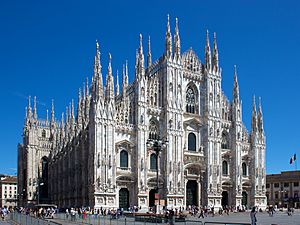
Milan has a rich history of architecture and art. There are only a few parts left of the ancient Roman city, like the Colonne di San Lorenzo. In the 4th century, Saint Ambrose, the bishop of Milan, helped shape the city. He built important churches like Sant'Ambrogio.
Milan's Cathedral is a huge church built between 1386 and 1877. It's the largest church in Italy and the third largest in the world. It's a great example of Gothic architecture. A golden statue of the Virgin Mary on top of the Duomo became a famous symbol of Milan.
In the 15th century, the Sforza family ruled Milan. They made an old fortress into the beautiful Castello Sforzesco. Famous artists like Leonardo da Vinci and Bramante worked on buildings in Milan during this time.
In the 18th century, Empress Maria Theresa of Austria made many improvements to Milan. This included building Teatro alla Scala, a famous opera house, in 1778. The Royal Palace was also renovated.
During Napoleon's rule (1805–1814), Milan became the capital of a new kingdom. New wide roads, squares, and cultural places were built. The large Arch of Peace is often compared to the Arc de Triomphe in Paris. In the late 19th century, Milan became a major industrial center. The beautiful Galleria Vittorio Emanuele II, with its glass roof, was built then.
In the early 20th century, new styles like Art Nouveau (called Liberty in Italy) appeared. After World War II, Milan rebuilt quickly. Modern skyscrapers like the Pirelli Tower and Torre Velasca were built. In recent years, old industrial areas have been transformed into modern business districts like Porta Nuova and CityLife. These areas have some of the tallest buildings in Milan, including the Unicredit Tower.
Parks and Green Spaces
The biggest parks in central Milan are Sempione Park and Montanelli Gardens. Sempione Park has a civic arena, an aquarium, a tower, and a Japanese garden. Montanelli Gardens has the Natural History Museum and a planetarium. Milan is working to create more green areas and plans to plant three million trees by 2030.
Monte Stella is an artificial hill made from debris after World War II bombings. Even though it's only 25 meters high, it offers great views of the city and the Alps. A special area in the park, the "Giardino dei Giusti," honors people who fought against injustice.
The Orto Botanico di Brera is a botanical garden with old trees like the Ginkgo biloba. Milan also has regional parks protecting farmlands and woodlands around the city.
People of Milan
Population Changes
| Population census | ||
|---|---|---|
| Year | Pop. | ±% |
| 1861 | 267,621 | — |
| 1871 | 290,518 | +8.6% |
| 1881 | 354,045 | +21.9% |
| 1901 | 538,483 | +52.1% |
| 1911 | 701,411 | +30.3% |
| 1921 | 818,161 | +16.6% |
| 1931 | 960,682 | +17.4% |
| 1936 | 1,115,794 | +16.1% |
| 1951 | 1,274,187 | +14.2% |
| 1961 | 1,582,474 | +24.2% |
| 1971 | 1,732,068 | +9.5% |
| 1981 | 1,604,844 | −7.3% |
| 1991 | 1,369,295 | −14.7% |
| 2001 | 1,256,211 | −8.3% |
| 2011 | 1,242,123 | −1.1% |
| 2021 | 1,371,498 | +10.4% |
| Istat historical data 1861–2021 | ||
As of 2018, about 1.38 million people lived in Milan. The population grew by about 11% since 2011. Milan's population was highest in 1973, with over 1.7 million people. After that, many people moved to the suburbs.
Milan has the second-largest community of people from East Asia in Europe, after Paris. Many people from the Philippines and China live here. The wider Milan area is home to over 8.2 million people.
People from Other Countries
Nationality held by residents as of 2023 Italian (81.20%) EU area (2.06%) Other European (1.67%) African (4.41%) Asian (8.08%) Latin American (2.90%) Other (0.08%)
| Country of foreign nationality | Population |
|---|---|
| 39,890 | |
| 37,073 | |
| 32,464 | |
| 15,523 | |
| 15,470 | |
| 13,571 | |
| 11,334 | |
| 8,705 | |
| 8,004 | |
| 7,787 | |
| 5,823 | |
| 4,605 | |
| 3,639 | |
| 2,751 | |
| 2,604 | |
| 2,575 | |
| 2,341 | |
| 2,330 | |
| 2,303 | |
| 2,032 | |
| 1,829 | |
| 1,780 | |
| 1,718 | |
| 1,651 | |
| 1,558 | |
| 1,517 | |
| 1,408 | |
| 1,402 | |
| 1,263 | |
| 1,188 | |
| 1,105 | |
| 1,073 | |
| 1,028 | |
| 1,005 | |
| other countries | each <1000 |
In 2021, about 261,277 foreign residents lived in Milan, making up 19.2% of the total population. This number has more than doubled in the last 15 years. After World War II, many people moved to Milan from poorer parts of Italy. Since the late 1980s, many people from other countries have moved here.
These immigrants came from Africa (like Egypt, Morocco, Senegal), Eastern Europe (like Romania, Ukraine), Asia (like China, Sri Lanka, Philippines), and Latin America (like Peru, Ecuador). Milan is now one of the most diverse cities in Italy.
Milan has the oldest and largest Chinese community in Italy, with about 32,500 people in 2023. This community started in the 1920s. Milan also has a large English-speaking community.
Religion in Milan
Most people in Milan are Catholic, just like in the rest of Italy. Milan is home to the Archdiocese of Milan. The greater Milan area also has communities of Protestants, Eastern Orthodox Christians, Jews, Muslims, Hindus, Sikhs, and Buddhists.
Milan has been a Christian city since Roman times. St. Ambrose, a famous bishop, influenced the city's religious history. The Ambrosian Rite is a special Catholic way of worship used in Milan, which is a bit different from the usual Roman Rite.
Milan has the largest Orthodox Christian community in Italy. There are many Orthodox churches and monasteries in the Milan area. The Jewish community in Milan is the second largest in Italy, after Rome.
Milan also has one of the largest Muslim communities in Italy. In 2014, the city council agreed to build a new mosque. As of 2018, about 9% of the city's population is Muslim. There are also many Hindus and Sikhs in Lombardy, especially around Milan.
Milan's Economy
Milan is Italy's economic capital and a global financial center. It's one of Europe's top economic cities. Milan and the Lombardy region produce a large part of Italy's wealth. Milan is the wealthiest city in Italy.
While Rome is Italy's political and cultural capital, Milan is its industrial and financial heart. The Milan area has about 45% of all businesses in the Lombardy region. Milan is also one of the most expensive cities in Europe. Via Monte Napoleone is Europe's most expensive shopping street.
Since the late 1800s, Milan has been a major industrial center. Big companies like Alfa Romeo and Falck used to employ thousands of workers here. Today, other global industrial companies like Pirelli have their main offices in Milan. Other important industries include chemicals, home appliances, food, and machinery.
Milan is Italy's biggest financial hub. Many national and international banks and insurance companies are located here. The Associazione Bancaria Italiana (Italian banking system) and the Milan Stock Exchange are both in the city. The Porta Nuova business district is home to the Italian offices of many global companies like Amazon and Google. The CityLife business district also hosts large multinational service companies.
The city has many media and advertising agencies, national newspapers, and telecommunication companies. This includes RAI (public broadcaster) and Mediaset (private TV). Milan is also home to major Italian publishing companies. There has been a fast increase in IT companies in Milan.
Milan is one of the world's fashion capitals. The fashion industry here has 12,000 companies and 800 showrooms. Many famous Italian fashion brands like Armani, Prada, and Versace are based in Milan. The city hosts Milan Fashion Week twice a year. Milan's main luxury fashion area, quadrilatero della moda, has the most expensive shopping streets.
Milan is also a global center for events and trade fairs. Fiera Milano runs Europe's largest permanent exhibition center. Big international exhibitions like the Milan Furniture Fair take place here, attracting millions of visitors.
Visiting Milan
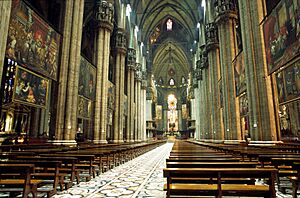
Tourism is a growing part of Milan's economy. In 2018, Milan had 8.81 million international visitors, making it the world's 15th most visited city. Most international visitors come from Europe, but many also come from China, Japan, and the United States. Milan is the second most visited city in Italy, after Rome.
The city has many popular tourist spots. These include the Milan Cathedral and Piazza del Duomo, the Teatro alla Scala opera house, the San Siro Stadium, the Galleria Vittorio Emanuele II, and the Castello Sforzesco. Other important places to visit are the Basilica di Sant'Ambrogio, the Navigli canals, and the Brera district. Milan also has many hotels, including very luxurious ones.
Milan's Culture
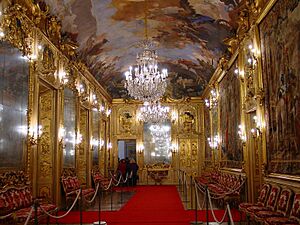
Museums and Art
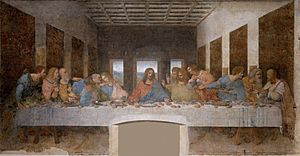
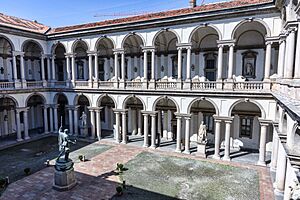
Milan has many cultural places, museums, and art galleries. The Pinacoteca di Brera is one of the most important art galleries. It has a great collection of Italian paintings, including famous works. The Castello Sforzesco has many art collections, including sculptures, ancient weapons, and furniture. It also has Michelangelo's last sculpture, the Rondanini Pietà.
Milan's art scene grew a lot in the Middle Ages. The Visconti family supported artists, making the city a center for Gothic art. Leonardo da Vinci worked in Milan from 1482 to 1499. He painted The Last Supper here.
In the 17th and 18th centuries, Milan was influenced by the Baroque style. Famous artists like Caravaggio worked here. The Museum of Risorgimento tells the story of Italy's unification. The Triennale is a design museum that shows modern Italian design, architecture, and art.
In the 20th century, Milan was a key place for the Futurist art movement. Today, Milan is still a major center for modern and contemporary art. The Modern Art Gallery has Italian and European paintings from the 18th to early 20th centuries. The Museo del Novecento focuses on 20th-century art, especially Futurism. There are also many private art spaces and public art projects around the city.
Music Scene
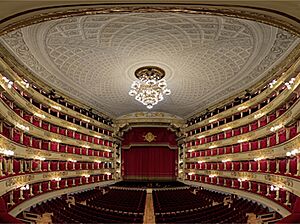
Milan is a big center for performing arts, especially opera. The city is home to La Scala opera house, which is one of the most famous in the world. Many famous operas had their first performances here, like Nabucco by Giuseppe Verdi. Milan also has a well-known symphony orchestra and a music conservatory. Many famous composers and musicians have lived and worked in Milan. The city is also the birthplace of many modern bands.
Fashion and Design
Milan is known worldwide for its industrial design, fashion, and architecture. In the 1950s and 60s, Milan became a global capital of design. Modern buildings like the Pirelli Tower were built. Today, Milan is especially famous for its high-quality furniture and interior design. The city hosts FieraMilano, Europe's largest trade exhibition, and the Salone Internazionale del Mobile, a very important furniture and design fair.
Milan is also one of the world's fashion capitals, along with New York City, Paris, and London. Many famous Italian fashion brands like Valentino, Versace, Prada, and Armani have their main offices in Milan. The city hosts Milan Fashion Week twice a year, which is a huge event in the fashion world. Milan's main luxury fashion area, quadrilatero della moda, has the city's most fancy shopping streets, like Via Monte Napoleone.
Languages and Books
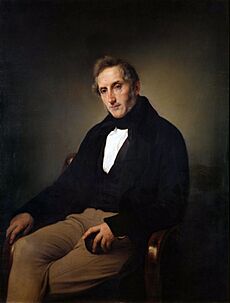
In the late 18th and 19th centuries, Milan was an important place for ideas and writing. Writers like Cesare, Marquis of Beccaria, influenced new middle-class culture.
In the early 19th century, the Romantic movement greatly affected the city's cultural life. Later, Alessandro Manzoni wrote his famous novel I Promessi Sposi, which is considered a key work of Italian Romanticism. At the same time, Carlo Porta wrote poems in the local Milanese dialect.
After Italy was united in 1861, Milan remained important for cultural discussions. New ideas from other European countries were discussed here.
Besides Italian, about 2 million people in Northern Italy can speak the Milanese dialect or other local variations of the Lombard Language.
Media in Milan
Milan is an important media center. Corriere della Sera, founded in 1876, is one of Italy's oldest newspapers. La Gazzetta dello Sport, a sports newspaper, is the most widely read daily newspaper in Italy. Other local newspapers include Il Giorno and Il Sole 24 Ore, a business newspaper.
Milan is also home to many magazines about architecture, art, and fashion, like Vogue Italia. Several big TV networks, like Mediaset, have their main offices in the Milan area. Many national radio stations are also based in Milan.
Milanese Food
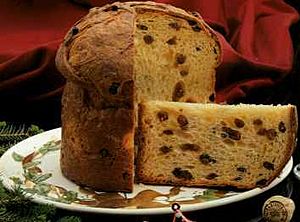
Milan has its own traditional food. Like other northern Italian cuisines, it uses more rice than pasta and butter more often than vegetable oil. It also uses very little tomato or fish.
Some typical Milanese dishes include cotoletta alla milanese, which is a breaded veal cutlet fried in butter. Another is ossobuco, which is braised veal shank. risotto alla milanese is a famous rice dish with saffron.
For holidays, there are special pastries like chiacchiere for Carnival and colomba (a dove-shaped cake) for Easter. Panettone is a famous sweet bread from Milan, eaten at Christmas. The salame Milano is a well-known salami. Famous Milanese cheeses include gorgonzola, mascarpone, and taleggio.
Milan is known for its world-class restaurants and cafes. Many historical restaurants and bars can be found in the city center and the Navigli districts.
Sports in Milan
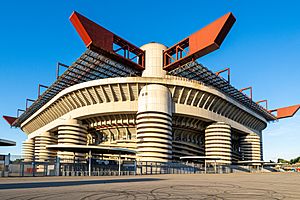
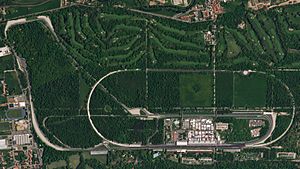
Milan has hosted many big sports events. It held matches for the FIFA World Cup in 1934 and 1990. Milan will host the 2026 Winter Olympics and 2026 Winter Paralympics along with Cortina d'Ampezzo.
Milan is one of only two cities in Europe with two European Cup/Champions League winning football teams: AC Milan and Inter Milan. They are two of the most successful football clubs in the world. Both teams play at the Giuseppe Meazza Stadium, also known as the San Siro. This is one of the biggest stadiums in Europe.
Milan is also home to Olimpia Milano, Italy's most successful basketball club. They have won many Italian and European championships. The team plays at the Mediolanum Forum.
The Monza Circuit, near Milan, hosts the Formula One Italian Grand Prix. It's one of the world's oldest car racing tracks.
In cycling, Milan is the starting point for the annual Milan–San Remo race. It's also the traditional finish line for the final stage of the Giro d'Italia, one of cycling's three major tours.
Learning in Milan

Milan is a major center for higher education and research. It has the second-largest number of universities in Italy, after Rome. In 2011, about 185,000 students were enrolled in Milan's universities.
Universities
The University of Milan (also called the "State University") was founded in 1924. It's the largest public university in the city, with about 60,000 students. Many famous people, including a former Italian Prime Minister and Nobel Prize winners, studied here.
The University of Milano-Bicocca was established in 1998. It's a newer university focused on science and technology. It ranks among the best young colleges in the world.
The Polytechnic University of Milan is the city's oldest university, founded in 1863. With over 40,000 students, it's Italy's largest technical university. It's ranked among the best in the world for engineering, design, and architecture. It is the best university in Italy.
The Catholic University of the Sacred Heart is the largest private university in Europe. It's also the largest Catholic university in the world.
Bocconi University is a private university for management and finance, started in 1902. It's considered the best in Italy for its fields and one of the best in the world.
The Vita-Salute San Raffaele University is a private medical university connected to the San Raffaele Hospital.
The University Institute of Languages and Communication (University IULM) started in 1968. It was the first Italian university to offer courses in public relations.
Art Schools
Milan is also known for its fine arts and music schools. The Milan Academy of Fine Arts was founded in 1776. The New Academy of Fine Arts is the largest private art and design university in Italy. Other schools include the European Institute of Design and the Marangoni Institute for fashion. The Milan Conservatory is Italy's largest music college.
Getting Around Milan
Milan is a very important transport hub in Italy and southern Europe. Its central railway station is Italy's second busiest. The Malpensa, Linate, and Orio al Serio airports serve the greater Milan area.
Azienda Trasporti Milanesi (ATM) is Milan's public transport company. It runs 5 metro lines, 18 tram lines, and many bus and trolleybus lines. It carries about 776 million passengers each year. ATM also manages parking and bike and car sharing systems.
Trains in Milan
Underground Metro
The Milan Metro is the underground train system for the city. It has 5 lines and 121 stations, mostly underground. It carries 1.15 million passengers every day, making it the largest in Italy. It's also one of the largest metro networks in Europe.
Suburban Trains
The Milan suburban railway service has 11 lines that connect the metropolitan area to the city center. These lines connect to all the metro lines. Many of these trains run through an underground section called "il Passante."
National and International Trains
Milan Central station is Italy's second busiest and one of the busiest in Europe. It handles 110 million passengers each year. High-speed trains connect Milan to Rome, Naples, and Turin. Milan also has direct international trains to cities like Paris, Geneva, and Zurich.
Milan is also the center of Lombardy's regional train network. A company called Trenord operates these trains, carrying over 750,000 passengers daily.
Buses and Trams
Milan's tram network has about 160 km of tracks and 18 lines. The bus lines cover over 1,070 km. Milan also has taxi services. The city is a key point for Italy's road network, with major highways connecting to it. Many long-distance bus lines link Milan to other towns and cities.
Airports
Milan has three airports for civilian flights: Milan Malpensa Airport, Milan Linate Airport, and Milan Bergamo Airport. Together, these airports handle over 51.4 million passengers and about 700,000 tons of goods each year. This makes Milan's airport system the busiest in Italy for both passengers and cargo.
- The Milan Malpensa Airport (MXP) is Italy's second-busiest airport for passengers and the busiest for cargo. It's a large international airport serving northern Italy and parts of Switzerland. It's connected to Milan by train and bus.
- Milan Linate Airport (LIN) is Milan's city airport, very close to the center. It's mainly used for flights within Italy and short international flights. It's connected to Milan by the M4 blue metro line.
- Milan Bergamo Airport (BGY) is mainly used for low-cost and charter flights. It's located about 45 km northeast of Milan.
There's also a smaller airfield called Bresso Airfield for general aviation and emergency helicopter services.
Cycling in Milan
Bicycles are becoming more popular for getting around Milan. Since 2008, the city has been building a network of bike paths to help with traffic and air pollution. During the COVID pandemic, many new bike lanes were quickly added.
The bike sharing system called BikeMi is available throughout the city and is very popular. You can also find many stationless bike and scooter sharing systems.
Milan's International Connections
Sister Cities
Milan has "sister city" relationships with many cities around the world:
 São Paulo, Brazil, since 1961
São Paulo, Brazil, since 1961 Chicago, United States, since 1962
Chicago, United States, since 1962 Lyon, France, since 1967
Lyon, France, since 1967 Saint Petersburg, Russia, since 1967
Saint Petersburg, Russia, since 1967 Frankfurt, Germany, since 1969
Frankfurt, Germany, since 1969 Birmingham, United Kingdom, since 1974
Birmingham, United Kingdom, since 1974 Dakar, Senegal, since 1974
Dakar, Senegal, since 1974 Shanghai, China, since 1979
Shanghai, China, since 1979 Osaka, Japan, since 1981
Osaka, Japan, since 1981 Tel Aviv, Israel, since 1997
Tel Aviv, Israel, since 1997 Bethlehem, Palestine, since 2000
Bethlehem, Palestine, since 2000 Toronto, Canada, since 2003
Toronto, Canada, since 2003 Kraków, Poland, since 2003
Kraków, Poland, since 2003 Melbourne, Australia, since 2004
Melbourne, Australia, since 2004 Daegu, South Korea, since 2015
Daegu, South Korea, since 2015
Famous People from Milan
Honorary Citizens
People who have been given the special title of "honorary citizen" of Milan include:
| Date | Name | Notes |
|---|---|---|
| 24 February 1972 | Charlie Chaplin (1889–1977) | A famous English comic actor. |
| March 1980 | Andrei Sakharov (1921–1989) | A Russian scientist and activist. |
| December 1988 | Alexander Dubček (1921–1992) | A politician from Czechoslovakia. |
| 16 February 1990 | Paola Borboni (1900–1995) | An Italian actress. |
| 21 October 2004 | Rudolph Giuliani (1944–present) | An American politician and former mayor of New York City. |
| 3 September 2005 | Rania Al-Abdullah (1970–present) | The Queen of Jordan. |
| 10 December 2008 | Al Gore (1948–present) | An American politician and former Vice President. |
| 18 January 2012 | Roberto Saviano (1979–present) | An Italian journalist and writer. |
| 4 April 2016 | Nino Di Matteo (1961–present) | An Italian judge. |
| 20 October 2016 | Dalai Lama (1935–present) | The spiritual leader of Tibetan Buddhism. |
| 10 December 2020 | Patrick Zaki (1991–present) | An Egyptian student. |
See also
 In Spanish: Milán para niños
In Spanish: Milán para niños


